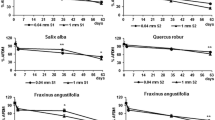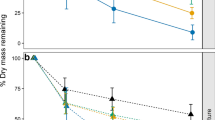Summary
Thein situ breakdown ofNymphoides peltata (Gmel.) O. Kuntze has been studied with special attention for methodology by: (1) using fresh and pre-dried material to establish the influence of pre-drying on breakdown and losses of nutrient stocks during decomposition; (2) enclosing different amounts of material in litter bags; (3) using litter bags with different mesh sizes, and (4) placing litter bags in water (floating leaves, petioles), on the sediment (long shoots) and in the hydrosoil (short shoots, roots). Of the material incubated in water, the floating leaves decomposed at a faster rate than the petioles, while the long shoots had the slowest breakdown. In the sediment the short shoots disappeared at a faster rate than the roots. By incubating the same morphological structure, both in the water and the sediment it appeared that the rate of breakdown was faster in the upper layers of the sediment. Pre-dried plant parts showed in water a larger initial weight loss than normal senescent plant parts, while in the sediment dried plant parts had a significantly slower loss of mass than the freshly incubated structures. Losses of nutrient stocks during decomposition were also markedly altered by pre-drying the material. When a larger amount ofNymphoides material was enclosed in the bags a tendency of a faster decay could be demonstrated. Macro-invertebrates colonized the litter bags with the 0.5 mm mesh size but usually could not-enter the 0.25 mm mesh size bags. The browsing of the detritivores did not result in a faster disappearance of organic matter, but organic matter must have been transported into the bags resulting in a larger amount of remaining organic matter when compared with the 0.25 mm mesh size bags.
Similar content being viewed by others
References
ANDERSEN, F.Ø., 1978. Effects of nutrient level on the decomposition ofPhragmites communis Trin. Arch. Hydrobiol., 84:42–54.
BASTARDO, H., 1979. Laboratory studies on decomposition of littoral plants. Pol. Arch. Hydrobiol., 26:267–299.
BOYD, C.E., 1970. Losses of mineral nutrients during decomposition ofTypha latifolia. Arch. Hydrobiol., 66:511–517.
CARPENTER, S.R. and M.S. ADAMS, 1979. Effects of nutrients and temperature on decomposition ofMyriophyllum spicatum L. in a hard water eutrophic lake. Limnol. Oceanogr., 24:520–528.
DANELL, K. and K. SJÖBERG, 1979. Decomposition ofCarex andEquisetum in a northern Swedish lake: dry weight loss and colonization by macro-invertebrates. J. Ecol., 67:191–200.
DOKULIL, M., 1975. Bacteria in the water and mud of Neusiedlersee (Austria). Symp. Biol. Hung., 15:135–140.
GODSHALK, G.L. and R.G. WETZEL, 1978a. Decomposition of aquatic angiosperms. I. Dissolved components. Aquat. Bot., 5:281–300.
GODSHALK, G.L. and R.G. WETZEL, 1978b. Decomposition of aquatic angiosperms. II. Particulate components. Aquat. Bot., 5:301–327.
HARRISON, P.G. and K.H. MANN, 1975. Detritus formation from eelgrass (Zostera marina): The relative effects of fragmentation, leaching and decay. Limnol. Oceanogr., 20:924–934.
HOWARD-WILLIAMS, C. and B.R. DAVIES, 1979. The rates of dry matter and nutrient loss from decomposingPotamogeton pectinatus in a brackish south-temperate coastal lake. Freshwat. Biol., 9:13–21.
HOWARD-WILLIAMS, C. and W.A. HOWARD-WILLIAMS 1978. Leaching of nutrients from swamp vegetation in an African lake. Aquat. Bot., 4:257–267.
HOWARD-WILLIAMS, C. and W.J. JUNK, 1976. The decomposition of aquatic macrophytes in the floating meadows of a central Amazonian Várzea lake. Biogeographica, 7:115–123.
HOWARTH, R.W. and S.G. FISHER, 1976. Carbon, nitrogen, and phosphorus dynamics during leaf decay in nutrient-enriched stream micro-ecosystems. Freshwat. Biol., 6:221–228.
HUNTER, R.D., 1976. Changes in carbon and nitrogen content during decomposition of three macrophytes in freshwater and marine environments. Hydrobiologia, 51:119–128.
KAUSHIK, N.K. and H.B.N. HYNES, 1971. The fate of the dead leaves that fall into streams. Arch. Hydrobiol., 68:465–515.
KORMONDY, E.J., 1968. Weight loss of cellulose and aquatic macrophytes in a Carolina bay. Limnol. Oceanogr., 13:522–526.
KOTZ, L., G. KAISER, P. TSCHÖPEL und G. TÖLG, 1972. Aufschluss biologischer Matrices für die Bestimmung sehr niedriger Spurenelementgehalte bei begrenzter Einwaage mit Salpetersäure unter Druck in einem Teflongefäss. Z. Anal. Chem., 260:207–209.
LAMMENS, E.H.R.R. and G. VAN DER VELDE, 1978. Observations on the decomposition ofNymphoides peltata (Gmel.) O. Kuntze (Menyanthaceae) with special regard to the leaves. Aquat. Bot., 4:331–346.
MASON, C.F. and R.J. BRYANT, 1975. Production, nutrient content and decomposition ofPhragmites communis Trin. andTypha angustifolia L. J. Ecol., 63:71–96.
NICHOLS, D.S. and D.R. KEENEY, 1973. Nitrogen and phosphorus release from decaying water millfoil. Hydrobiologia, 42:509–525.
ROELOFS, J.G.M. An instrumental method for the estimation of organic carbon in seston, macrophytes and sediments (in prep.).
TWILLEY, R.R., 1976. Phosphorus cycling inNuphar communities. In: M.M. Brinson and G.J. Davies, Eds. Primary Productivity and Mineral Cycling in Aquatic Macrophyte Communities of the Chowan River, North Carolina. Water Resources Research Institute Publication, University of North Carolina, p. 36–91.
VAN DER VELDE, G., 1979.Nymphoides peltata (Gmel.) O. Kuntze (Menyanthaceae), as a food plant forCataclysta lemnata (L.) (Lepidoptera, Pyralidae). Aquat. Bot., 7:301–304.
VAN DER VELDE, G., 1980. Studies in nymphaeid-dominated systems with special emphasis on those dominated byNymphoides peltata (Gmel.) O. Kuntze (Menyanthaceae). Thesis. Nijmegen. Stichting Studentenpers. Nijmegen. 163pp.
VAN DER VELDE, G., 1981. A project on nymphaeid-dominated systems. Hydrobiol. Bull. (Amsterdam), 15:185–189.
VAN DER VELDE, G., Th. G. GIESEN and L.A. VAN DER HEIJDEN, 1979. Structure, biomass and seasonal changes in biomass ofNymphoides peltata (Gmel.) O. Kuntze (Menyanthaceae), a preliminary study. Aquat. Bot., 7:279–300.
VERHOEVEN, J.T.A., 1980. The ecology ofRuppia-dominated communities in Western-Europe. III. Aspects of production, consumption and decomposition. Aquat. Bot., 8:209–253.
WOHLER, J.R., D.B. ROBERTSON and H.R. LAUBE, 1975. Studies on the decomposition ofPotamogeton diversifolius. Bull. Torrey Bot. Club, 102:76–78.
Author information
Authors and Affiliations
Rights and permissions
About this article
Cite this article
Brock, T.C.M., Huijbregts, C.A.M., Van de Steeg-Huberts, M.J.H.A. et al. In situ studies on the breakdown ofNymphoides peltata (Gmel.) O. Kuntze (Menyanthaceae); Some methodological aspects of the litter bag technique. Hydrobiological Bulletin 16, 35–49 (1982). https://doi.org/10.1007/BF02255411
Issue Date:
DOI: https://doi.org/10.1007/BF02255411




